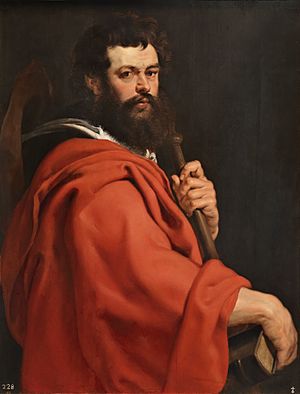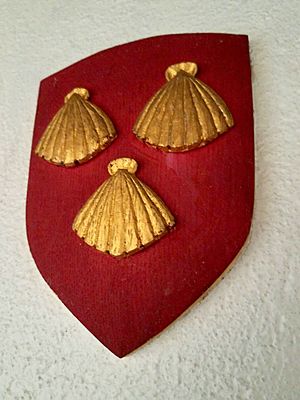James the Great facts for kids
Quick facts for kids SaintJames the Great |
|
|---|---|

St James the Elder (c. 1612–1613) by Peter Paul Rubens
|
|
| Apostle and Martyr | |
| Born | Bethsaida, Galilee, Roman Empire |
| Died | AD 44 Jerusalem, Judea, Roman Empire |
| Honored in | All Christian denominations that venerate saints |
| Canonized | Pre-Congregation |
| Feast | 25 July (Western Christianity) 30 April (Eastern Christianity) 30 December (Hispanic Church) |
| Attributes | Red Martyr, Scallop, Pilgrim's hat |
| Patronage | Places Spain, Guatemala, Seattle, Levoča, Nicaragua, Guayaquil, Betis Church, Guagua, Pampanga, Badian, Cebu, Bolinao, Pangasinan, Ibaan, Batangas, Pasuquin, Ilocos Norte, Plaridel, Bulacan, Paete, Laguna, Sogod, Cebu, Compostela, Cebu, Santiago de Chile and some places of Mexico. Professions Veterinarians, equestrians, furriers, tanners, pharmacists, oyster fishers, woodcarvers. |
James the Great was one of the Twelve Apostles of Jesus. He is also known as James, son of Zebedee, or Saint James the Greater. He was the first apostle to be killed for his beliefs.
Saint James is considered the patron saint of Spain. Many people believe his remains are kept in Santiago de Compostela in Galicia.

Contents
James in the Bible
James was the son of Zebedee and Salome. He was the brother of John the Apostle. He is called "the Greater" to tell him apart from another apostle named James "the Less". "Greater" here likely means older or taller.
Becoming a Disciple
The Bible says that James was one of the first people to follow Jesus. He and his brother John were fishing with their father when Jesus called them. They left everything to follow him.
James, his brother John, and Peter were very close to Jesus. They were the only apostles allowed to be with Jesus during some special moments. These included when Jesus brought Jairus' daughter back to life, when Jesus was transformed (called the transfiguration of Jesus), and during his difficult time in the Garden of Gethsemane.
Sons of Thunder
James and John were sometimes called "Boanerges," which means "Sons of Thunder." This nickname might have come from their strong personalities. For example, once they wanted to call down fire on a town that didn't welcome Jesus. Jesus, however, told them not to.
His Death
The book of Acts of the Apostles in the Bible tells us that King Herod Agrippa had James killed with a sword. This made James the first apostle to die for his faith.
Honoring Saint James
Saint James is a very important saint in the Catholic Church. He is the patron saint of Spain. Many people believe his body rests in Santiago de Compostela in Galicia.
The Way of St. James
The city of Santiago de Compostela is famous for a long walking journey called the "Way of St. James" (or Camino de Santiago). This journey has been a popular pilgrimage for hundreds of years. Pilgrims walk or bike many miles to reach the saint's tomb. In 2018, over 327,000 pilgrims completed the last 100 kilometers (about 62 miles) of the walk.
When July 25th (Saint James's feast day) falls on a Sunday, it's called a "Holy Year." During these years, a special door at the Santiago Cathedral is opened for pilgrims. The next Holy Year will be in 2027.
Feast Day
Saint James's feast day is celebrated on July 25th in many Christian churches, including Roman Catholic and Anglican churches. Some Eastern Orthodox churches celebrate it on April 30th. July 25th is also a special holiday in Galicia, Spain, because Saint James is their patron saint.
His Story in Jerusalem and Spain
Martyrdom in Jerusalem
The place where Saint James was killed is believed to be inside the Armenian Apostolic Cathedral of St. James in Jerusalem. There is a special chapel there, and people believe his head is buried under the altar.
Preaching in Spain
An old story says that James traveled to Hispania (modern-day Spain) to share Jesus's teachings. Later, after he was killed in Jerusalem, his followers are said to have taken his body by sea to Spain. They landed in Padrón and then carried his body to Santiago de Compostela for burial.
According to another tradition, the Virgin Mary appeared to James in Spain around AD 40. She stood on a pillar, which is now honored in the Basilica of Our Lady of the Pillar in Zaragoza, Spain. After this, James returned to Jerusalem, where he was killed.
The discovery of Saint James's remains in the 9th century led to the start of the famous pilgrimage route. The shrine in Santiago de Compostela became a very important place for Christians to visit.
Saint James the Moor-Slayer
A medieval legend says that Saint James miraculously appeared to help Christian armies fight against the Moors (Muslims) in Spain. Because of this, he was sometimes called Santiago Matamoros, meaning "Saint James the Moor-slayer." The battle cry of Spanish Christian armies used to be "St. James and strike for Spain!"
Symbols of Saint James
The symbol of Saint James is the scallop shell. Pilgrims often wear this shell on their hats or clothes. In French, a scallop is called coquille St. Jacques, meaning "cockle of St. Jacob." In German, it's Jakobsmuschel, meaning "Jacob's mussel."
Military Order of Santiago
The Order of Santiago was a military group founded in Spain in the 12th century. It was named after Saint James and its members fought against the Moors. Over time, being a member of this order became a sign of great honor.

Other Beliefs
Latter-day Saints
The Church of Jesus Christ of Latter-day Saints believes that in 1829, Saint James, along with Peter and John, appeared to Joseph Smith and Oliver Cowdery. They believe these apostles gave them special religious authority.
In Islam
In Islam, the Quran talks about the followers of Jesus, but it doesn't name them. However, Muslim scholars generally agree with the New Testament list of disciples, which includes James.
Images for kids
-
Saint James as the Moor-killer by Giovanni Battista Tiepolo at the Museum of Fine Arts, Budapest.
-
According to Catholic tradition, James preached the message and teachings of Jesus Christ in Hispania. In the year 44, he was beheaded in Jerusalem and his remains were later transferred to Galicia in a stone boat, to the place where stands Santiago de Compostela Cathedral.
See also
 In Spanish: Santiago el Mayor para niños
In Spanish: Santiago el Mayor para niños
- Apocryphon of James (also known as the Secret Book of James)
- Camino de Santiago
- Cathedral of St. James
- Hand of St James the Apostle
- Military Order of Saint James of the Sword
- Peter of Rates
- Saint James, son of Zebedee, patron saint archive
- James Matamoros
- St. James' Church





